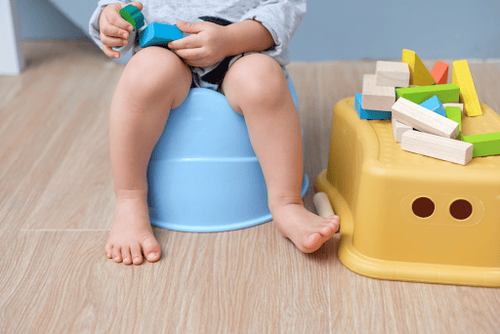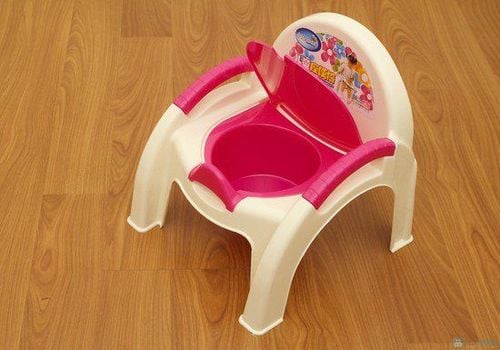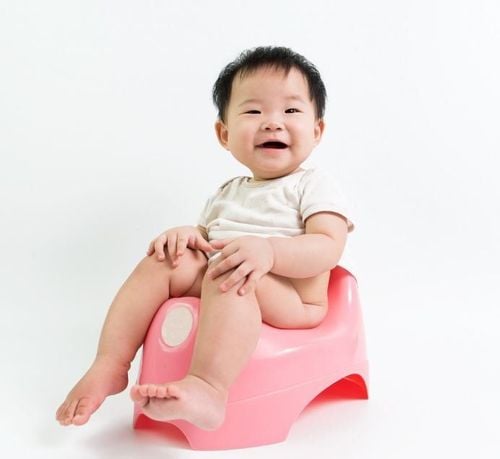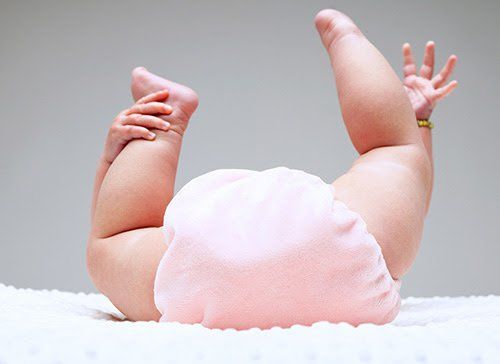This is an automatically translated article.
You think it's time to teach your son how to use the potty, but you don't know where to start. Potty training is not simply about sitting on the potty and going to the toilet, but also needs to be trained in other skills such as the ability to recognize the need to use the toilet on their own, wait until When going to the bathroom, take off your pants and sit long enough to finish going to the bathroom.This depends on the normal cognitive, emotional and physiological development of the child, and usually appears only after 18-24 months of age.
1. Determining the best time to start potty training your boy
Teaching boys how to use the potty requires a fair amount of cooperation and motivation, plus your time and patience.
The key to success in potty training is when your son is interested, ready, and physically fit. Although some children are ready at an early age - around 18 months, others may not be ready to learn this until past their third birthday.
Some experts suggest that boys spend a little longer in diapers than girls because they are usually more active.
There's no point in trying to start potty training too early. When parents start potty training too early, the process can take longer. In other words, you will reach your destination at the same time, no matter when you start. The best way is to check if your son is ready to learn how to use the potty.
Once you have determined that your son is ready to start potty training, focus on taking the time to guide him. Stress or major life changes, such as a new sibling moving or your family moving, can make toilet training difficult.
Make sure your child's routine is well established. Wait until your baby seems open to new things, then you can successfully potty train.
2. Let your baby watch and learn
Toddlers will learn by imitating and watching you use the toilet as the first step, which comes naturally. Your baby may notice that dad uses the toilet differently than mom, which provides a great opportunity for you to explain the basic mechanics of how boys use the toilet.
You need to make sure to be anatomically correct when talking about body parts. You can teach your baby to call his penis with another, more adorable and memorable name like "wet bed". Make sure you don't use that name for any other body part.

Cha mẹ cần dạy trẻ quan sát và bắt chước sử dụng nhà vệ sinh
3. Choosing the right potty
When the child is sitting on the potty, it is important that the child can lean forward slightly with his feet on the ground, especially when he has a bowel movement. Most experts recommend buying a baby-sized potty.
It is better that the baby can choose his own potty, so he will feel more secure than sitting on a large toilet. In fact, many toddlers are afraid of falling on the toilet and their anxiety can interfere with potty training.
If you prefer to buy an adapter seat for your regular toilet, make sure it is comfortable and securely attached to the toilet. Also, buy a stool for your son so that he can easily get on and off the toilet whenever he needs to go and can also stabilize himself on his feet.
When buying a potty for your son, look for one that doesn't have a urine guard (or has a removable part). While they can protect your bathroom from a bit of urine spilling out, they also tend to scrape a boy's penis when he sits down on the potty, which can make him shy from using it.
You may want to show your son related picture books or videos to try to help him grasp all this new information. You can even buy a doll and a miniature potty so your child can easily visualize what you are teaching him.
4. Make your child comfortable with the potty
It is important for your baby to feel comfortable with the potty, because only then will your baby enjoy using them. You need to first familiarize your child with the idea of using the potty. Start by telling your baby that the potty is her own. You can personalize it by writing your baby's name on it or let him decorate it with stickers. Then let the child try sitting on it with his or her clothes.
After your child has practiced this way for a week or so, ask her to try sitting on the potty with her pants down. If the child seems resistant, avoid the temptation to pressure him. That would only set up a decision-making contest, possibly derailing the entire training process.
If your child has a favorite doll or stuffed animal, use it to demonstrate potty training. Most children love to watch their toys make movements, and they can learn a lot more this way than from you telling them what to do.
Some parents even set up toilets specifically for dolls or stuffed animals. While the child sits on the potty, his or her toys can be placed on another potty.
5. Encourage him with cool underwear
Help your child focus on the benefits of potty training by taking your child to do a special job of buying underwear for him. Let him know he can choose whatever he wants: animal or train pants, shorts or shorts, whatever appeals to him.
You should talk about the outing ahead of time so that your child is excited about being potty-aged and wearing "real" underwear, like that of his dad or brother. If your baby seems a little hesitant to put them on, see if she wants to wear them over her diaper. Once they get used to them, they may insist on giving up diapers.

Huấn luyện trẻ ngồi bô cần theo trình tự và thời gian
6. Schedule training
Diaper removal depends on your daily schedule and whether your son is at home or daycare. If your child is in daycare, you'll want to coordinate with your child's teacher.
You will have to decide whether to switch between diapers and underwear or just switch to underwear for the entire day. Disposable workout pants are convenient, but many experts and parents find that it's best to switch immediately to old-fashioned cotton underwear or pants, both of which help your son feel when he's sick. wet immediately. Of course, that means you'll be cleaning up in some situations.
When making decisions, consider what's best for you and your son. For a while, keep using disposable diapers or pants at night and when you're out and about.
Your child's daycare or preschool teacher may have their own opinion about when to switch to underwear at school. At this point, you need to discuss to agree with the teacher on when to let your child wear underwear instead of diapers.
7. Teach your child to sit first, then stand
Bowel and urine movements often come at the same time, so you should initially let your son sit down to poop and pee. That way, the child knows that they both go to the potty. Kids also won't be distracted by the fun of spitting out waste and learn to focus on mastering the basic process.
You need to pay attention to the time your child spends on the potty, avoid letting him sit for too long, about 5 minutes is enough, or be absorbed by other activities. Watching television or using other screens while on the potty is often a major obstacle for parents and children.
When your child feels comfortable sitting down on the potty, he or she can try standing up and urinating. However, there is no reason to rush this, the boy can continue to pee and sit for as long as he wants.
This is where masculinity is key. Make sure your son can follow his dad, uncle, brother or a good family friend to the bathroom to observe how a son pees. When your son seems to get the idea, let him try.
8. No diapers
There's nothing to help kids know when to go to the bathroom, place the potty in an easily accessible area while they play and encourage them to sit on it at regular intervals.
Of course if the child is not wearing a diaper, it is obvious that the floor is wet. Have your child play in an area that is not damaged by moisture or cover carpets and furniture with plastic.
Watch for signs that your child wants to go to the bathroom, such as hugging or jumping up and down on the spot, and use these cues to suggest that it might be time to potty. You can do this for days in a row, in the evenings when the whole family gets together, or just on weekends. The more time a child spends without a diaper, the faster he or she will learn to use the potty.

Trẻ sẽ biết cách sử dụng bô nhanh hơn khi cha mẹ huấn luyện tốt
9. Encourage your child to sit on the potty successfully
The first stage of potty training for children will be difficult, but eventually the child will enjoy knowing how to use the potty. Celebrate this moment by celebrating the victory. Show your child that he or she has reached a milestone by rewarding them with a "big kid" perk, such as watching a new video or being able to stay on the playground longer.
However, don't overdo it every time your child learns to use the potty, or else he or she may start to feel nervous and afraid of all the attention other people give him when he goes to the bathroom.
10. If your child doesn't succeed at first, try again
As with any other skill, the more your baby uses the potty, the better he will be at it. But there are some things you can do to make it easier for your child to learn to use the potty. For example, dress your child in loose-fitting clothes so they can take them off easily, or buy underpants that are a little larger.
If your child is still having trouble potty training, don't overreact or punish him. Because nothing interrupts potty training faster than making a child feel bad when something goes wrong.
If you're feeling down, remind yourself that yelling at your child for wetting his pants can make diapers last longer. Remember that potty training isn't too different from learning how to ride a bicycle, and accidents are an inevitable part of the process. Even kids who have successfully used the toilet for months sometimes have an accident while engrossed in an activity.
And if you don't feel like making much progress or if you or your child are becoming frustrated, you can completely pause potty training and try again in a few weeks.
11. Enhance the fun factor of potty training
You can try some of the following ways to make potty training more enjoyable for your child, which can help them quickly complete potty training.
If you approach potty training with a little soft music, your child will be more likely to stay motivated. Put some blue food coloring in the potty. Children will be amazed at how they can turn water green. Put a few of your baby's favorite books in the magazine rack next to the toilet so she can see them whenever she has to go to the bathroom. Or better yet, read to him, if that's not distracting. If your child is starting to lose interest but is already potty training well, you can consider offering a reward. Using stickers and calendars to keep track of your child's successes is one of the popular methods. Every time they go to the potty, they get a sticker they can put on the page of the book. Viewing cumulative stickers will keep kids inspired. If the stickers themselves aren't exciting enough, you can offer an extra reward, such as a gift or a toy, when your child earns enough patches or keeps his pants dry for a certain number of days during the day. row.

Trẻ sẽ thích thú với việc ngồi bô sau một thời gian thích nghi
12. Switch to potty training at night
Once your baby's pants stay dry all day, you can start planning for potty training at night. Wait until your baby is comfortable using the potty during the day, then start checking diapers in the morning and after naps to see if they're dry. Many children begin to keep their pants dry during their naps within 6 months of learning to use the potty.
Night training takes longer because it depends mainly on whether the baby's body can hold urine for a long time. It can take months or years before your child's body is mature enough to stay dry at night, and this is completely normal. According to the American Academy of Pediatrics, 10% of 7-year-olds and 5% of 10-year-olds can still wet the bed at night.
If your baby wants to sleep without a diaper, let him or her do it. If a few nights of testing show your baby isn't ready, put the diaper back on. Tell her that her body isn't quite ready for this next step, and reassure her that she'll soon be old enough to try again.
If your child doesn't wet the bed for 3 to 5 nights, maybe you should let him use the potty "anytime, anywhere". Support your child's efforts by limiting the amount of water he or she drinks after 5 p.m. and teaching him to go to the bathroom one last time before bed. If your child takes a long time to keep his pants dry at night, don't worry about it. Because this is considered normal until the child reaches grade one.
13. Skip diapers
By the time your baby is ready to say goodbye to diapers altogether, he's already overcome a lot of challenges.
Acknowledge this and reinforce your pride in your child and in his accomplishments.
In addition, in order to prevent diseases that babies often get, parents should pay attention to nutrition to improve children's resistance. At the same time, add supporting foods containing lysine, essential micro-minerals and vitamins such as zinc, chromium, selenium, B vitamins,... snacks and less digestive problems.
Parents can learn more:
Why do you need to supplement Lysine for your baby?
The role of zinc - Guidelines for reasonable zinc supplementation
Please visit the website Vinmec.com regularly and update useful information to take care of your baby and family.
Reference article source: babycenter.com













